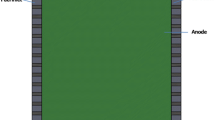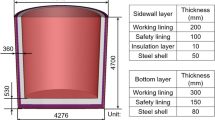Abstract
In the present study, turbulent flow fields in diverse carbon steel pipe components leading to flow accelerated corrosion (FAC) are analyzed using the Realizable turbulence model. The present study is inspired by the detailed case studies of flow accelerated corrosion in nuclear power plants around the globe. The Numerical study is conducted with the main objective of analyzing the flow around the recirculation regions arising in different piping components, such as sudden expansion, double elbow, orifice and T-bend, since these components are known to be more susceptible to FAC. Employed Realizable k-ε turbulence model and the flow simulations are validated with the Experimental and Numerical results available in the literature. The topological consistency is verified by means of a topological invariance relation of the flow based on the Euler number. The calculated reattachment length increased, but the concentration of ferrous ions decreased or remained almost constant at the corner recirculation regions as a function of Reynolds number. As the shear stress distribution is one of the most important factors in predicting the local regions of pipes that are highly susceptible to FAC, this distribution was calculated in the considered geometries. These results would help to select the components that are more susceptible to FAC. In addition, the locations of the maximum wall shear stress are identified in each component. It is observed that the double elbow and orifice are two components that are more susceptible to FAC among all the considered components.

Similar content being viewed by others
Abbreviations
- C:
-
Counter-rotating cell
- C p :
-
Specific heat
- D:
-
Diameter
- D1 :
-
Diffusion coefficient
- E:
-
Elliptic point
- G k :
-
Generation of turbulent kinetic energy
- J :
-
Mass diffusion flux
- k :
-
Turbulent kinetic energy per unit mass
- \({k_s^+ }\) :
-
Non-dimensional wall roughness height
- k s :
-
Roughness height
- k eff :
-
Effective conductivity
- k th :
-
Thermal conductivity
- p :
-
Static pressure
- P:
-
Parabolic point
- Pr t :
-
Turbulent Prandtl number
- Re :
-
Reynolds number
- Sc:
-
Schmidt number
- Sct :
-
Turbulent Schmidt number
- T :
-
Temperature
- U :
-
Velocity
- U 1 :
-
Axial velocity
- U 2 :
-
Transverse velocity
- u :
-
Mean velocity
- u′:
-
Fluctuating velocity
- Y :
-
Mass fraction of ferrous ions
- \({\tau}\) :
-
Wall shear stress
- \({\kappa}\) :
-
Von-Karman’s constant
- ρ :
-
Density
- μ :
-
Viscosity
- ν :
-
Kinematic viscosity
- ν t :
-
Kinematic turbulent viscosity
- μ t :
-
Turbulent or eddy viscosity
- ε :
-
Rate of dissipation
- δ ij :
-
Kronecker delta
- ξ :
-
Euler number
- \({\tau_{\max}}\) :
-
Maximum wall shear stress
References
Pietralik, J.M.; Smith, B.A.W.: CFD applications to flow accelerated corrosion in feeder bends, Proceedings of the 14th International Conference on Nuclear Engineering (ICONE-14), Miami, FL, pp. 89323 (2006)
Ahmed W.H.: Evaluation of the proximity effect on flow accelerated corrosion. Ann. Nucl. Energy 37, 598–605 (2010)
Kanster W., Erve M., Henzel N., Stellwag B.: Calculation code for erosion corrosion induced wall thinning in piping system. Nucl. Eng. Des. 119, 431–438 (1990)
Kain V., Roychowdhury S., Mathew T., Bhandakkar A.: Flow accelerated corrosion and its control measures for the secondary circuit pipelines in Indian nuclear power plants. J. Nucl. Mater. 383, 86–91 (2008)
Kang D.G., Jo J.C.: CFD application to the regulatory assessment of FAC-caused CANDU feeder pipe wall thinning issue. J. Nucl. Eng. Technol. 40(1), 37–48 (2008)
Pietralik, J.M.: Mass transfer effects in feeder flow-accelerated corrosion wall thinning. In: 18th CNS International Conference on CANDU Maintenance, Toronto, Nov. 16–18, CW-33126-CONF-009 (2008)
Pietralik, J.M.; Schefski, C.S.: Flow and mass transfer in bends under flow-accelerated corrosion wall thinning conditions. J. Eng. Gas Turbines and Power 133, 012902-1 to 012902-7(2011)
Pietralik, J.M.; Heppner, K.L.: Flow-accelerated corrosion susceptibility prediction of recirculating steam generator internals. In: Proceedings of the 16th International Conference on Nuclear Engineering, ICONE16, May 11–15, Orlando, Florida, USA, ICONE16-48630 (2008)
Fingjun L., Lin Y., Li X.: Numerical simulation for carbon steel flow-induced corrosion in high-velocity flow seawater. J. Anti-Corros. Methods Mater. 55(2), 66–72 (2008)
Gammal M.Al., Ahmed W. H., Ching C. Y.: Investigation on wall mass transfer characteristics downstream of an orifice. Nucl. Eng. Des. 242, 353–360 (2012)
Kim J.W., Na M.G., Park C.Y.: Effect of local wall thinning on the collapse behavior of pipe elbows subjected to a combined internal pressure and in-plane bending load. J. Nucl. Eng. Des. 238, 1275–1285 (2008)
Kain V., Roychowdhury S., Ahmedabadi P., Barua D K.: Flow accelerated corrosion: experience from examination of components from Indian nuclear power plants. Eng. Fail. Anal. 18(8), 2028–2041 (2011)
Singh J. L.; Umesh, K.; Kumawat, N.; Sunil, K.; Kain, V.; Anantharaman, S.; Sinha A. K.: Flow accelerated corrosion of carbon steel feeder pipes, from pressurized heavy water reactors J. Nucl. Mater. 429, 226–232 (2012)
Chen X., McLaury B.S., Shirazi S.A.: A comprehensive procedure to estimate erosion in elbows for gas/liquid/s and multiphase flow. ASME J. Energy Resour. Technol. 128, 70–78 (2006)
Founti, M.; Achimastos, Th.; Dimopoulos, D.: Effects of increasing particle loading in an axisymmetric vertical liquid-solid sudden expansion flow. In: Experimental and computational aspects of validation of multiphase flow cfd codes. ASME Fluid Eng. Div. 180, 83–92 (1994)
Smith, E.; Artit, R.; Somravysin, P.: Promvonge Numerical investigation of turbulent flow through a circular orifice, KMITL Sci. J., 8(1), 43–50 (2008)
Debnath R., Somnath B., Arindam M., Roy D., Snehamoy M.: A comparative study with flow visualization of turbulent fluid flow in an elbow. Int. J. Eng. Sci. Technol. 2(9), 4108–4121 (2010)
Armbya, N.: CFD analysis of 3-d thermal hydraulics flow effects on wall concentration gradient profiles for LBE loop fittings, M.Sc Thesis, University of Nevada, Las Vegas (2004)
Shih T.H., Liou W.W., Shabbir A., Yang Z., Zhu J.: A new k-ε eddy-viscosity model for high Reynolds number turbulent flows—model development and validation. Comput. Fluids 24(3), 227–238 (1995)
Brown, G.J.: Numerical simulation of separated flows in three—dimensional industrial geometries: a case study. Int. Conf. on CFD in Mineral Metal Process. Power Gener. 157–164 (1997)
ANSYS Fluent® version 12.1 Users Guide (2009)
Founti M., Klipfel A.: Experimental and computational investigations of nearly dense two-phase sudden expansion flows. Exp. Thermal Fluid Sci. 17, 27–36 (1998)
Cable, M. An Evaluation of Turbulence Models for the Numerical Study of Forced and Natural Convective Flow in Atria, M.Sc thesis, Queen’s University Kingston, Ontario, Canada (2009)
Zoka H.M., Omidvar A.: A comparative assessment of a compressible reynolds stress model and some variant k-ɛ models for engine flow applications. Arab. J. Sci. Eng. 37(6), 1737–1749 (2012)
Jana S.C., Matacalfe G., Ottino J.M.: Experimental and a computational study of mixing in complex stokes flows: the vortex mixing flow and multicellular cavity flows. J. Fluid Mech. 269, 199–246 (1994)
Drazin, P.G.; Reid, W.H.: Hydrodynamic Stability. Cambridge University Press, Cambridge (1981)
MA, T.; Wang, S.: Structure of 2D incompressible flows with the Dirichlet boundary conditions, Discret. Contin. Dyn. Syst. B, 1, 29–41 (2001)
Adams E.W., Johnston J.P.: Effects of the separating shear layer on the reattachment flow structure Part 2: reattachment length and wall shear stress. Exp. Fluids 6, 493–499 (1988)
Pietralik J.M.: The role of flow in flow accelerated corrosion under nuclear power plant conditions. E-J. Adv. Maint. 4(2), 63–78 (2012)
Majid Z.A., Mohsin R.: Failure investigation of natural gas pipeline. Arab. J. Sci. Eng. 37(4), 1083–1088 (2012)
Author information
Authors and Affiliations
Corresponding author
Rights and permissions
About this article
Cite this article
Hari Ponnamma, R., Teegala, D., Ravi Ranjan, S. et al. Numerical Simulation of Turbulent Flow in Carbon Steel Pipes Leading to Flow Accelerated Corrosion. Arab J Sci Eng 39, 6435–6451 (2014). https://doi.org/10.1007/s13369-014-1262-9
Received:
Accepted:
Published:
Issue Date:
DOI: https://doi.org/10.1007/s13369-014-1262-9




